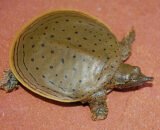- You have no items in your shopping cart
- Subtotal: $0.00
Housing: A semi-aquatic habitat measuring at least 4 feet by 4 feet is necessary for spotted turtles. A temperature of about 75 to 80 degrees Fahrenheit should be maintained for the water in order to keep it clean. There should be enough cover on the land in the form of rocks, vegetation, and logs.
Diet: Observed Due to their omnivorous nature, turtles need a broad diet. Provide live or frozen insects like crickets, mealworms, and waxworms along with commercial turtle food. Strawberries, bananas, and leafy greens are just a few examples of the fruits and vegetables they like.
Water: Make sure there is plenty available for bathing and drinking. A shallow water dish that is big enough for them to soak in but not so deep that they can’t reach the bottom is essential.
Health: Respiratory infections and shell rot are two potential health issues for spotted turtles. Ensure routine veterinary care and uphold a clean, sanitary atmosphere. Every day, remove waste and uneaten food from the enclosure.
Spotted turtle are not a species that take well to handling. To minimize stress and help the turtle feel comfortable and secure in its enclosure, handling should be kept to a minimum.
To ensure that calcium and other crucial elements are properly absorbed, UVB illumination should be provided.
Temperature: To allow for thermoregulation, keep the temperature in the basking area at about 85 degrees Fahrenheit.
Remember that spotted turtles are a long-lived species that demand a big commitment in addition to this care advice. Before getting one as a pet, it’s necessary to think about the long-term commitment because they can live for more than 20 years. Your Spotted Turtle can grow and live a long, healthy life if you give it a carefully managed environment, a balanced diet, and regular medical treatment.
It’s crucial to buy from a reputable breeder or adopt from a rescue group when considering a Spotted Turtle as a pet. Avoid buying turtles that were taken in the wild since they are frequently under stress and could be sick. Look for turtles with smooth shells, clean eyes, and a healthy appearance.
Overall, keeping a pet spotted turtle is an interesting and gratifying experience. You may appreciate the beauty and distinctive personality of this magnificent turtle for many years to come with the right care and attention.
With this thorough guide, which covers everything from housing and diet to health and handling, you can learn how to take care of a spotted turtle.
The proper habitat and nourishment must be provided when taking care of a Spotted Turtle for their health and well-being. You can make sure that your Spotted Turtle receives the care they require to thrive by paying attention to the advice provided in this article.
A semi-aquatic enclosure with lots of hiding spots and clean water is necessary for their habitat. The right nutrition can be provided by offering a diverse diet that includes commercial turtle food, insects, fruits, and vegetables. To lessen stress, it’s also crucial to give animals routine veterinarian treatment and to handle them as little as possible.
You can appreciate the beauty and personality of this remarkable species as a long-term pet by taking the time to learn about the specific requirements of the Spotted Turtle and providing them with a carefully managed environment. This thorough guide can assist you in giving your Spotted Turtle the best possible care, whether you are a seasoned reptile enthusiast or a novice turtle keeper.
Care: It takes a serious commitment to provide for a spotted turtle, as well as close attention to its needs. Here are some suggestions to make sure your spotty turtle gets the attention it needs to thrive:
Housing: A semi-aquatic habitat measuring at least 4 feet by 4 feet is necessary for spotted turtles. Clean water should be kept at a temperature of about 75 to 80 degrees Fahrenheit, and the enclosure should include both land and water regions. There should be cover on the land in the form of logs, plants, and rocks.
Diet: Observed Due to their omnivorous nature, turtles need a broad diet. Provide live or frozen insects like crickets, mealworms, and waxworms along with commercial turtle food. Strawberries, bananas, and leafy greens are just a few examples of the fruits and vegetables they like.
Water: Make sure there is plenty available for bathing and drinking. A shallow water dish that is big enough for them to soak in but not so deep that they can’t reach the bottom is essential.
Health: Respiratory infections and shell rot are two potential health issues for spotted turtles. Ensure routine veterinary care and uphold a clean, sanitary atmosphere. Every day, remove waste and uneaten food from the enclosure.
Spotted turtles are not a species that take well to handling. To minimize stress and help the turtle feel comfortable and secure in its enclosure, handling should be kept to a minimum.
To ensure that calcium and other crucial elements are properly absorbed, UVB illumination should be provided.
Spotted Turtles are a long-lived species that demand a big commitment, so it’s vital to keep that in mind. Before getting one as a pet, it’s necessary to think about the long-term commitment because they can live for more than 20 years. Your Spotted Turtle can grow and live a long, healthy life if you give it a carefully managed environment, a balanced diet, and regular medical treatment.
It’s crucial to buy from a reputable breeder or adopt from a rescue group when considering a Spotted Turtle as a pet. Avoid buying turtles that were taken in the wild since they are frequently under stress and could be sick. Look for turtles with smooth shells, clean eyes, and a healthy appearance.
Overall, taking care of a spotted turtle necessitates a committed dedication to their particular requirements. You can appreciate the beauty and distinctive personality of this lovely turtle for many years to come by paying attention to these suggestions and giving them a well maintained habitat.







Customer reviews
Reviews
There are no reviews yet.
Write a customer review